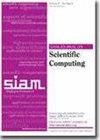Efficient Tensor-Product Spectral-Element Operators with the Summation-by-Parts Property on Curved Triangles and Tetrahedra
IF 2.6
2区 数学
Q1 MATHEMATICS, APPLIED
引用次数: 0
Abstract
SIAM Journal on Scientific Computing, Volume 46, Issue 4, Page A2270-A2297, August 2024.Abstract. We present an extension of the summation-by-parts (SBP) framework to tensor-product spectral-element operators in collapsed coordinates. The proposed approach enables the construction of provably stable discretizations of arbitrary order which combine the geometric flexibility of unstructured triangular and tetrahedral meshes with the efficiency of sum-factorization algorithms. Specifically, a methodology is developed for constructing triangular and tetrahedral spectral-element operators of any order which possess the SBP property (i.e., satisfying a discrete analogue of integration by parts) as well as a tensor-product decomposition. Such operators are then employed within the context of discontinuous spectral-element methods based on nodal expansions collocated at the tensor-product quadrature nodes as well as modal expansions employing Proriol–Koornwinder–Dubiner polynomials, the latter approach resolving the time step limitation associated with the singularity of the collapsed coordinate transformation. Energy-stable formulations for curvilinear meshes are obtained using a skew-symmetric splitting of the metric terms, and a weight-adjusted approximation is used to efficiently invert the curvilinear modal mass matrix. The proposed schemes are compared to those using nontensorial multidimensional SBP operators and are found to offer comparable accuracy to such schemes in the context of smooth linear advection problems on curved meshes, but at a reduced computational cost for higher polynomial degrees. Reproducibility of computational results. This paper has been awarded the “SIAM Reproducibility Badge: Code and Data Available” as a recognition that the authors have followed reproducibility principles valued by SISC and the scientific computing community. Code and data that allow readers to reproduce the results in this paper are available at https://github.com/tristanmontoya/ReproduceSBPSimplex and in the supplementary materials (reproducibility_repository.zip [35.7MB]).
在曲面三角形和四面体上具有逐部求和性质的高效张量积谱元算子
SIAM 科学计算期刊》,第 46 卷第 4 期,第 A2270-A2297 页,2024 年 8 月。 摘要。我们提出了将逐部求和(SBP)框架扩展到折叠坐标中的张量-乘积谱元算子。所提出的方法能够构建可证明的稳定的任意阶离散,这种离散结合了非结构化三角形和四面体网格的几何灵活性以及和因式分解算法的效率。具体来说,我们开发了一种方法,用于构建任意阶的三角形和四面体谱元算子,这些算子具有 SBP 特性(即满足离散的部分积分)以及张量-乘积分解。然后,在基于张量-乘积正交节点的节点展开以及采用 Proriol-Koornwinder-Dubiner 多项式的模态展开的非连续谱元方法中使用这些算子,后一种方法解决了与坍缩坐标变换奇异性相关的时间步长限制。通过对度量项进行偏斜对称拆分,获得了曲线网格的能量稳定公式,并利用权重调整近似法有效地反演了曲线模态质量矩阵。将所提出的方案与使用非张量多维 SBP 算子的方案进行了比较,发现在曲线网格上的平滑线性平流问题中,所提出的方案具有与此类方案相当的精确度,但对于较高的多项式度,计算成本却有所降低。计算结果的可重复性。本文被授予 "SIAM 可重现徽章":代码和数据可用性",以表彰作者遵循了 SISC 和科学计算界重视的可重现性原则。读者可以通过 https://github.com/tristanmontoya/ReproduceSBPSimplex 和补充材料(reproducibility_repository.zip [35.7MB])中的代码和数据重现本文的结果。
本文章由计算机程序翻译,如有差异,请以英文原文为准。
求助全文
约1分钟内获得全文
求助全文
来源期刊
CiteScore
5.50
自引率
3.20%
发文量
209
审稿时长
1 months
期刊介绍:
The purpose of SIAM Journal on Scientific Computing (SISC) is to advance computational methods for solving scientific and engineering problems.
SISC papers are classified into three categories:
1. Methods and Algorithms for Scientific Computing: Papers in this category may include theoretical analysis, provided that the relevance to applications in science and engineering is demonstrated. They should contain meaningful computational results and theoretical results or strong heuristics supporting the performance of new algorithms.
2. Computational Methods in Science and Engineering: Papers in this section will typically describe novel methodologies for solving a specific problem in computational science or engineering. They should contain enough information about the application to orient other computational scientists but should omit details of interest mainly to the applications specialist.
3. Software and High-Performance Computing: Papers in this category should concern the novel design and development of computational methods and high-quality software, parallel algorithms, high-performance computing issues, new architectures, data analysis, or visualization. The primary focus should be on computational methods that have potentially large impact for an important class of scientific or engineering problems.

 求助内容:
求助内容: 应助结果提醒方式:
应助结果提醒方式:


